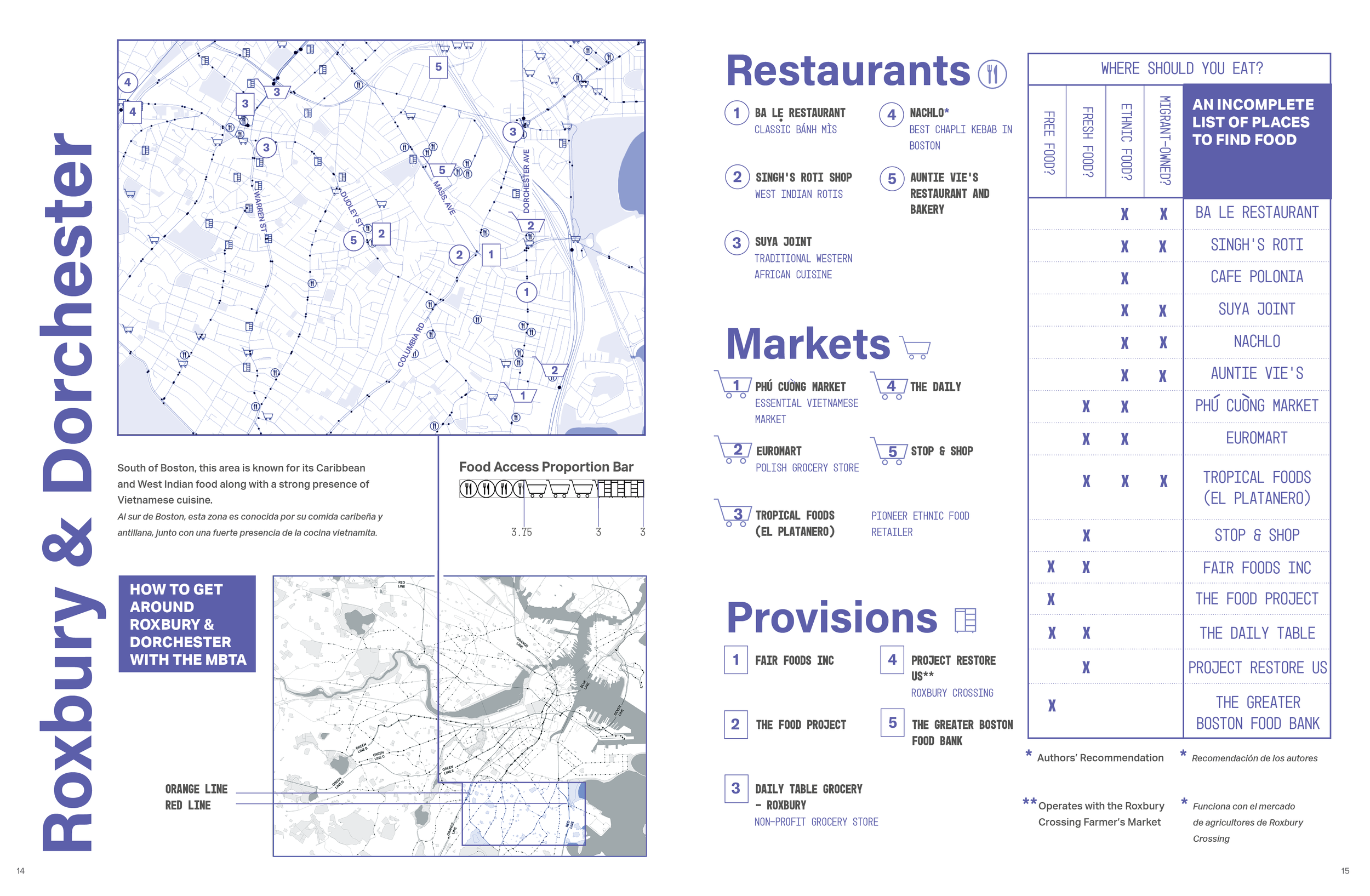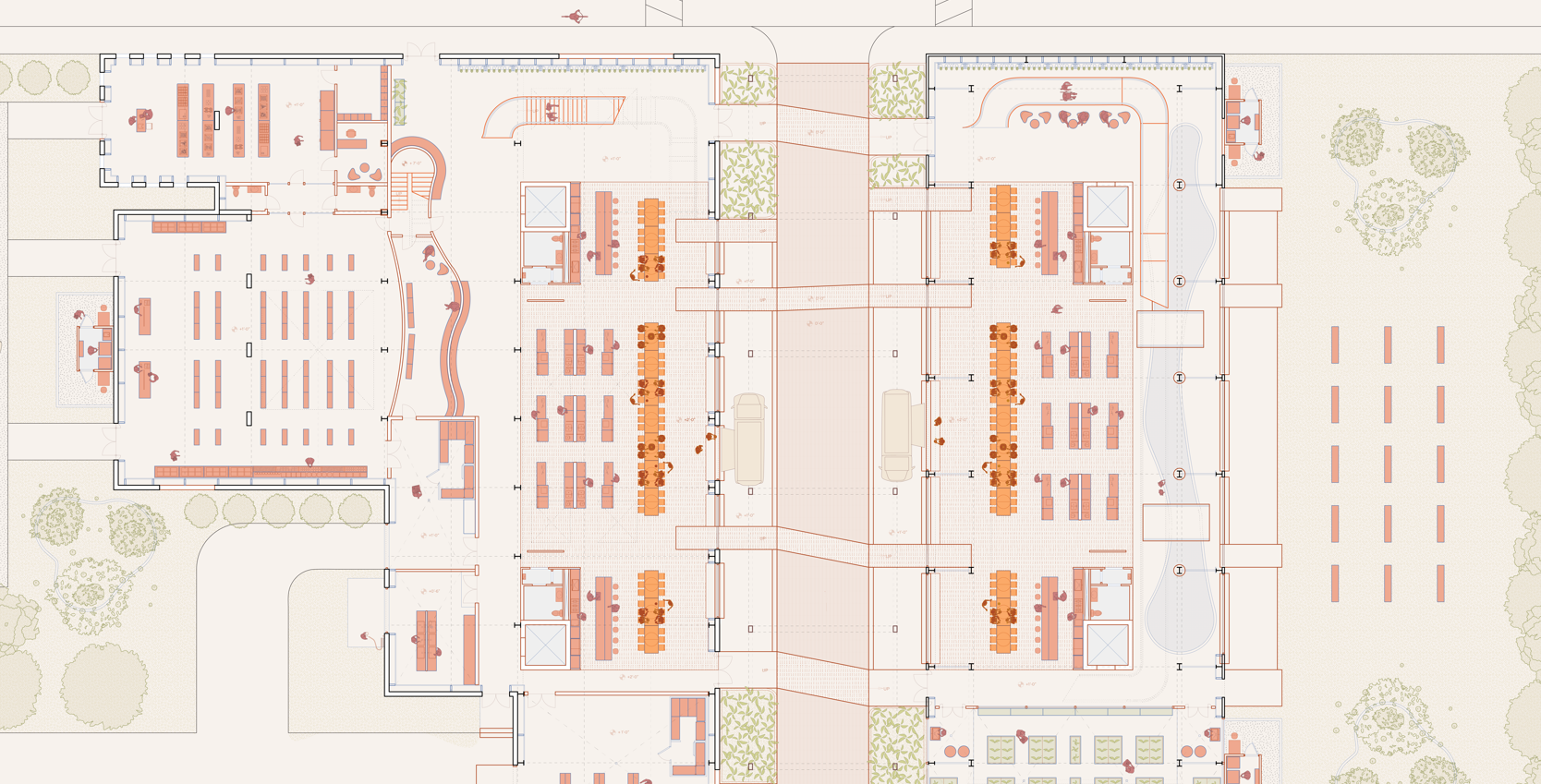a taste of home
This final post of “The Borders of Boston” takes us through our M.Arch thesis project, the synthesis of our months of exploring, eating, volunteering, and reflecting. ‘A taste of home’ is a thesis that explores the food landscape in Boston through the lens of the immigrant experience. The variety of restaurants, grocery stores, and food provisional organizations that we visited taught us first-hand the richness of culture found in places of food sharing, as well as the lack of dignity in places of food provision.
Boston’s Food Ecosystem
Our site research demonstrated to us that there was an existing larger Food Ecosystem Network that is overwhelming to discern as an individual. Restaurants and ethnic markets are spread out across Boston that serve the specific migrant communities within each neighborhood with the necessary culinary experiences and grocery items. Farmers markets across the city serve to provide fresh produce at reasonable prices to those that need it. Where there are gaps in the ability to access food, food provision organizations & community fridges are situated to bridge the gap of excess and scarcity.
However, food resources are unfairly allocated across the city. In Boston Proper, due to the high density of population, there is a large percentage of restaurants and markets available. As one moves further south, to the Roxbury and Dorchester area, there is a greater number of food provisional organizations compared to the restaurants and markets, indicating food deserts in areas that are dominated primarily by marginalized communities.
Food Ecosystem Map
Guidebook
The city’s food network is extremely complex, dispersed, and difficult to grasp at its vast scale. For an individual trying to navigate this complexity, it’s hard to know where to begin. To demystify some of this obscurity, we produced a guidebook: “An Incomplete Guide to Food in Boston” is a deployable guidebook that directs users to immigrant-owned restaurants and grocery markets, as well as food provision organizations in their area. The guide acknowledges both the diverse cuisines of Boston and the reality of food insecurity to begin to bridge the gap between the two ends of the spectrum of the immigrant experience.
The guidebook is written in both Spanish and English to make it more accessible to a broader audience, and is sectioned into six neighborhoods of Boston: Cambridge, Downtown Boston, East Boston, Allston, South Boston, and Dorchester. Each section maps and lists a sampling of immigrant-owned restaurants, grocery markets, and food provision organizations and indicates the comparative ratio of each. In addition to directing food seekers where to go, it also reveals areas of need to those with means to help.
Incomplete Guide to Food in Boston
Food Embassy Concept
As we discovered, there are gaps in the access to fresh and ethnic food that need to be addressed by a new social typology. Thus, we proposed the new concept of the Food Embassy, a new institution that brings together the joys of sharing food across cultures as well as with those in need.
An embassy is an institution that assists its people in a foreign place - it’s a home away from home, a safe space. In a similar manner, we believe a food embassy is an inviting and comforting place for those who seek familiar tastes & those who seek aid.
These Food Embassies would be spread out across the city of Boston to form a new network that would support each other. From creating food distribution centers that address food scarcity to introducing new markets and food centers, the Food Embassy would introduce a new form of social gathering that would be centered around the communal act of sharing a meal.
Food Embassy Model
Boston Food Embassy Network
In researching where to intervene, we performed a study of abandoned warehouses & distressed buildings (buildings that are longer in use and have dilapidated exterior conditions) in Boston to understand the existing structures that are available to be transformed and utilized. City-owned parcels were also identified as potential buildings for intervention for potential federal joint programs. The population distribution reveals which are the most suitable areas for an institution to serve the most people. Overall, the number of warehouses available were more prevalent in the neighborhoods of Allston, Dorchester/Roxbury & South Boston compared to Downtown Boston and Cambridge.
We chose six around Boston to create a new Distribution network that would address the gaps we perceived within the Food Ecosystem Network of Boston: Allston, Cambridge/ Somerville, East Boston, South Boston, Downtown Boston and Roxbury/Dorchester. We selected these warehouses & city parcels for their proximity to nearby T Stops and Bus Stops to promote greater accessibility. All six sites range in size to address different possible functions of the new distribution network.
Food Embassy Network Map
Choosing a Site
For our first site of intervention, we chose the neighborhood of Dorchester. It was important to us that we picked an area most in need based on our findings from our field work. In an early interview, we had spoken to Rescuing Leftover Cuisines, a decentralized food distribution organization that serves the Greater Boston Area by directly delivering excess food to those in need. Our conversation with the administrator revealed to us that the areas of Boston with the highest number of recipients were East Boston and Dorchester. This also aligned with a previous conversation with a community fridge organizer who informed us that the only community fridge in Dorchester had shut down due to an inability to meet the demand, which was causing internal conflict.
The Dorchester site houses two buildings, a metal storehouse and a brick warehouse that were both used for metal fabrication and storage. Intervening in these buildings allows us to revitalize an abandoned structure and transform it into a life source for its surrounding community.
Dorchester Site Map
The Project
In our visits to the City of Boston archives, we discovered historic plans for a railway to be implemented in between the two warehouses that would create a thoroughfare. To incorporate these ideas, we proposed to maintain the shells and internal structural grid of the two buildings and bridge them together with a central plaza in the space between. The plaza begins from inside both buildings, anchored at its corners by circulation and service cores, and stitched together in the center by a new roof above.
9 Dewar St, 1944 Plan. Courtesy of Boston City Archives
This plaza is a dynamic space that can host food market stalls, weekly farmer’s market, special events, performances—and even Greek wedding receptions. Large folding doors on the facades of either building open them up in good weather for indoor/outdoor fluidity. During the winter months, the embassy is transformed to insulate the buildings and hold life inside. The folding doors close, and market stalls operate inside as soup kitchens to feed those in need during the cold months.
Ground Floor Plans, Market Scenario & Winter Scenario
Alongside our Food Embassy, we designed the community fridge as our smallest and most deployable intervention. Located in three spots around the site, our proposal emphasizes openness and dignity in the exchange of food. Glazed lower panels allow others to determine whether someone is inside, while maintaining a sense of privacy. Anyone can enter this little house, whether it’s to drop off or pick up food from the fridge, to pick up an order from a ghost kitchen in the meal locker, or even just to wash one’s hands.
Community Fridge Proposal Section
The Review
On December 18th 2021, we presented our thesis work to critics internal and external to MIT. We curated the presentation as a dining experience where we invited our guests to follow along with menu books that we designed as they sat around a communal table with a model of our proposal. Little bowls featured furniture pieces and scale figures that we had prepared to allow for the critics to interact directly with the model and experience the “Food Embassy” for themselves. During the conversation, questions and topics emerged of the ability of food to change cultural differences: how many types of cuisines can we appropriate to “migrant” food? How does one design for the “back of house” and service cores of the project? Is there a sense of cultural tokenism in certain architectural elements, such as a gate? What are the financing options for creating a vendor space filled with volunteers?
Ana & Carol-Anne’s Thesis Day Presentation. Photos Courtesy of April Gao & Matthew Ledwidge
From our volunteering experiences to the new conversations we had, the past year of the project has been gratifying in several ways. Our investigations allowed us to view the city we have lived in the past four years in a new light. Now, we walk the neighborhoods of Boston with new reflections on its history and possible futures.
Though we had spent most of our time into the architecture of the proposal, there were still many things we had not considered. However, we do not see this project as finished but as a first step in further discussions to be had over food, culture and identity. This project has demonstrated to us that we are more alike than we are similar—which is a cause always worth designing for.
Thank you for joining alongside us on our journey.
-Ana & Carol-Anne














